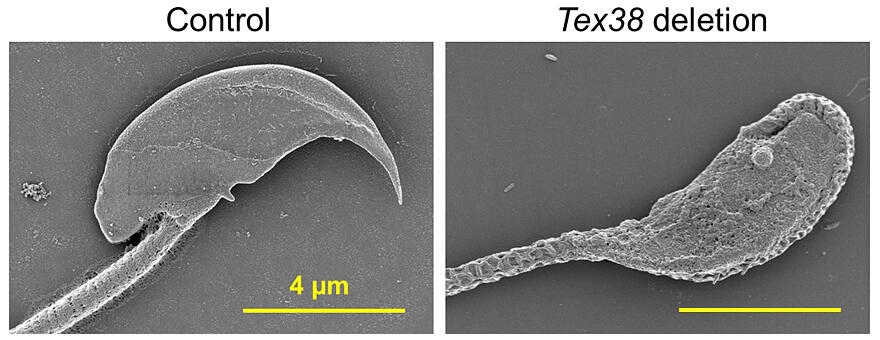A research group led by Graduate Student Yuki Kaneda at the Graduate School of Pharmaceutical Sciences, the University of Osaka, Specially Appointed Associate Professor Yonggang Lu at the Premium Research Institute for Human Metaverse Medicine, the University of Osaka, and Associate Professor Haruhiko Miyata and Professor Masahito Ikawa of the Research Institute for Microbial Diseases at the University of Osaka, has announced that they discovered the protein complex TEX38/ZDHHC19, which is important for spermatogenesis. This complex removes the perinuclear cytoplasm in spermatids via lipid modification of proteins essential for normal spermatogenesis. Abnormalities of these factors were found to result in sperm head bending and male infertility. The findings are expected to contribute to the diagnosis of male infertility and the development of male contraceptives. The results were published in the Proceedings of the National Academy of Sciences of the United States of America PNAS on March 3.

Provided by the University of Osaka
In developed countries, an estimated one in six couples is infertile, and half of these cases are attributed to male infertility. Approximately 80% of male infertility is due to spermatogenesis failure (decreased sperm count, abnormal morphology, and decreased motility). Various morphological abnormalities are known, but the causes are not well understood because the molecular mechanisms of spermatogenesis are largely unknown.
In this study, the research group searched for genes essential for spermatogenesis to understand the issue. Specifically, testis-specific genes were listed from databases and other sources, and male mice lacking each gene were created. Then, these male mice were mated with normal female mice to find genes essential for spermatogenesis based on infertility as an indicator.
As a result, males lacking the Tex38 gene failed to produce litters, or fertilize eggs through in vitro fertilization. To determine the underlying cause, they observed Tex38-deficient spermatids and found that they had abnormal head morphology and low motility. Spermatids from normal mice are characterized by a sickle-shaped head structure, but Tex38-deficient spermatids have the head bent 180°.
To further elucidate the function of the Tex38 gene, they used immunoprecipitation and other methods to identify proteins that bind to the TEX38 protein. The results showed that it binds to ZDHHC19. Mice deficient in the Zdhhc19 gene have been reported to show the same head morphological abnormalities as Tex38-deficient mice. When the TEX38 and ZDHHC19 protein levels in the testes were examined in both Tex38- and Zdhhc19-deficient mice, the ZDHHC19 and TEX38 levels were markedly reduced in the respective mice. These results suggest that TEX38 and ZDHHC19 form a complex and stabilize each other.
ZDHHC19 has already been reported to catalyze protein palmitoylation (a lipid modification to add palmitic acid to proteins). To investigate the role of the palmitoylation activity of ZDHHC19 in spermatogenesis, the research group generated mice in which a part of ZDHHC19 was replaced to produce ZDHHC19 without palmitoylation activity. Spermatids from these mice showed the same morphological abnormalities as those from Zdhhc19-deficient mice. This result indicates that the palmitoylation activity of ZDHHC19 plays an important role in spermatogenesis.
To determine proteins palmitoylated by ZDHHC19, they searched for proteins that interacted with ZDHHC19 and were not palmitoylated without functional ZDHHC19 and found ARRDC5. They also confirmed that ZDHHC19 palmitoylates ARRDC5. ARRDC5 gene-deficient mice have already been reported to exhibit abnormal sperm head morphology similar to that in Tex38-deficient mice. Finally, to clarify the cause of the abnormal sperm morphology, developing spermatozoa were observed and compared between normal and Zdhhc19-deficient mice.
The results showed that the perinuclear cytoplasm was removed just before the completion of spermatogenesis in normal mice. Meanwhile, the cytoplasm was not unremoved in spermatozoa from Zdhhc19-deficient mice. Failure to remove the perinuclear cytoplasm results in abnormal sperm head bending, and TEX38 and ZDHHC19 are thought to be involved in the cytoplasm removal. They also confirmed that morphologically abnormal spermatids from Tex38-deficient mice could produce litters through microinsemination, although the fertilization rate was a fraction of that of normal spermatids. These findings suggest that in humans with this type of spermatogenesis failure, the success rate of reproductive medicine may be improved by selecting microinsemination at an earlier stage.
Miyata said, "We know that TEX38 and ZDHHC19 are also present in human sperm. Dysfunction of these proteins can cause male infertility. We also believe that if ZDHHC19 stabilization by TEX38 or ARRDC5 palmitoylation by ZDHHC19 can be inhibited by some agents, such agents may lead to male contraceptives with fewer adverse effects."
Journal Information
Publication: PNAS
Title: TEX38 localizes ZDHHC19 to the plasma membrane and regulates sperm head morphogenesis in mice
DOI: 10.1073/pnas.2417943122
This article has been translated by JST with permission from The Science News Ltd. (https://sci-news.co.jp/). Unauthorized reproduction of the article and photographs is prohibited.




